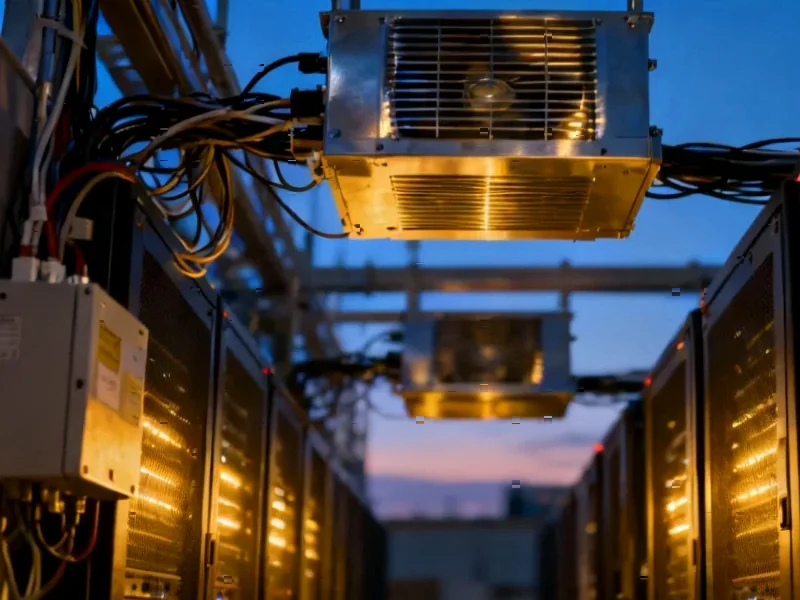According to TheRegister.com, xFusion presented at GITEX Global 2025 in Dubai a comprehensive hardware strategy addressing fundamental datacenter physics challenges that threaten AI infrastructure ROI. Their “Black Technology” suite includes innovations like a full liquid-cooling server cabinet achieving 1500W cooling performance, thermal interface materials doubling conductivity, and liquid coolant delivering 10% faster heat transfer. The company demonstrated a proven pPUE of less than 1.06, significantly below the global average datacenter PUE of 1.56 identified by the Uptime Institute in 2024 and even edging out Google’s cutting-edge 1.09 average. xFusion’s approach also includes custom power supply units achieving 96.2% efficiency and high-speed interconnects optimized for PCIe 5.0/6.0, with successful deployments in extreme environments like Algeria’s Sahara desert at 55°C temperatures.
The Thermodynamic Reckoning Coming for AI
What xFusion’s presentation reveals is that the AI industry is approaching a fundamental physics wall that no amount of software optimization can overcome. We’re witnessing the beginning of what I call the “thermodynamic reckoning”—the point where exponential growth in computational demand collides with the linear constraints of energy density and heat dissipation. The 1KW racks on NVIDIA’s roadmap represent just the opening salvo in a thermal arms race that will define which companies survive the next generation of AI development. Traditional air cooling has already hit its physical limits, and liquid cooling introduces its own cascade of engineering challenges that most organizations are woefully unprepared to address.
The Emerging Geography of AI Computation
The Middle East’s emergence as a strategic AI hub, highlighted by xFusion’s regional expansion, signals a fundamental shift in where computation will physically occur. As PwC’s research indicates, regions with cheap power and land will become the computational breadbaskets of the AI economy, much like how certain regions dominate agricultural or energy production. However, this geographic specialization creates new vulnerabilities—extreme climate conditions in these optimal locations demand radical innovations in thermal management, while geopolitical tensions could disrupt critical AI infrastructure concentrated in specific regions. The ENAGEO case study in Algeria demonstrates both the opportunity and the extreme engineering requirements for operating in these environments.
The Efficiency Arms Race Beyond GPUs
While most attention focuses on GPU performance, the real competitive advantage will come from peripheral systems—power supplies, interconnects, and cooling infrastructure. xFusion’s achievement of 96.2% PSU efficiency might seem incremental, but at hyperscale, these marginal gains translate to massive operational savings and reduced carbon footprints. The industry is shifting from measuring pure computational performance to evaluating total system efficiency across the entire power and cooling chain. Companies that master this holistic approach will achieve not just better economics but also regulatory compliance as governments increasingly scrutinize AI’s environmental impact. Google’s impressive 1.09 PUE, once the industry gold standard, is now the baseline that serious players must exceed.
The Digital Sovereignty Imperative
xFusion’s emphasis on open standards and multi-vendor compatibility reveals a deeper industry trend: the fragmentation of AI infrastructure along national and corporate lines. As the ENAGEO deployment in Algeria demonstrates, organizations are prioritizing control and security over pure performance. This “digital sovereignty” movement will accelerate as AI becomes more critical to national security and economic competitiveness. We’re moving toward an era where countries and major corporations will insist on controlling their entire AI stack—from chips to cooling—creating opportunities for infrastructure providers who can deliver complete, sovereign solutions rather than just individual components.
The 24-Month Survival Roadmap
Looking ahead, the companies that thrive in the AI infrastructure space won’t be those with the fastest chips, but those that solve the physics problems holistically. Within 24 months, I predict we’ll see: major hyperscalers making strategic acquisitions in cooling technology companies; regulatory frameworks mandating minimum efficiency standards for AI datacenters; and the emergence of “AI infrastructure as a service” models that abstract away these physics challenges for enterprises. The winners will be those who recognize that AI’s ultimate constraint isn’t processing power—it’s the fundamental laws of thermodynamics that govern how much computation we can physically sustain within our planetary boundaries.




